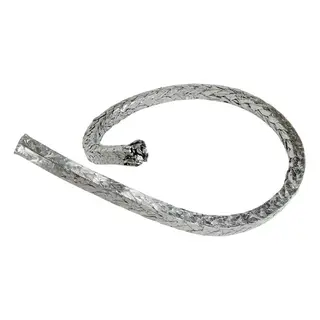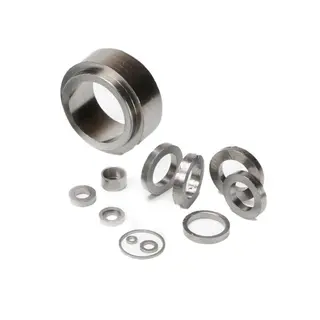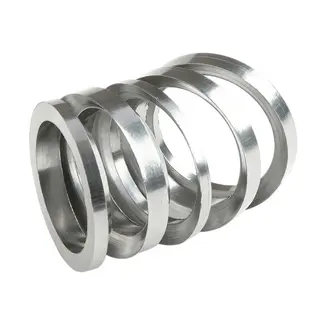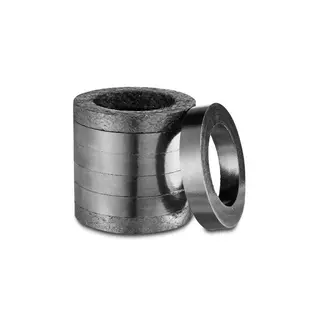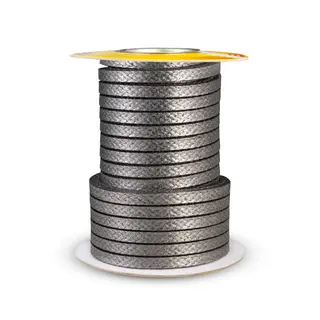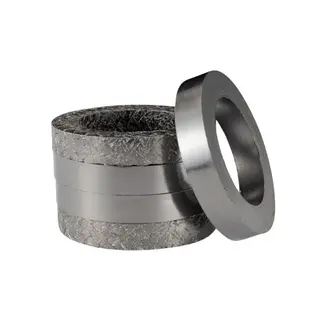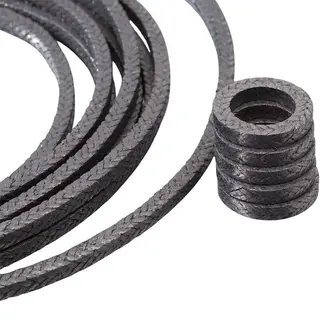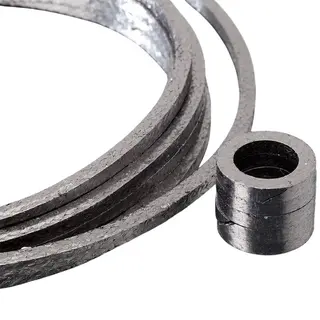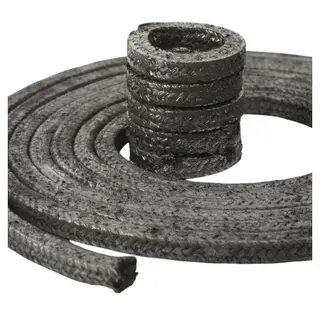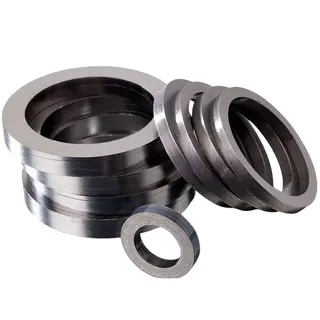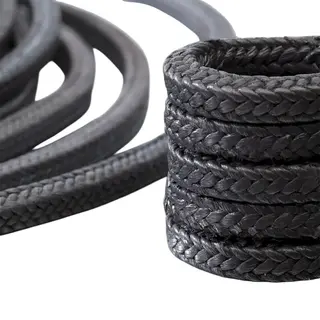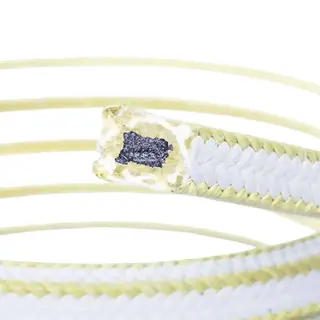To meet varying operational needs, graphite packing is available in several types. These types are classified based on:
Pure Graphite Packing: Made entirely of expanded graphite yarns; offers excellent chemical and thermal resistance.
Graphite with Inhibitors: Treated with corrosion inhibitors to protect valve stems or shafts.
Graphite with Lubricants: Enhanced with special lubricants for reduced friction and easier installation.
Inconel-Reinforced Graphite Packing: Reinforced with Inconel wire for higher strength and oxidation resistance in high-temperature applications.
Carbon Fiber-Reinforced Graphite Packing: Improves mechanical strength and abrasion resistance.
PTFE-Reinforced Graphite Packing: Combines chemical resistance of PTFE with the thermal stability of graphite.
Valve Packing: Designed for sealing stationary stems in high-temperature or high-pressure valves.
Pump Packing: Engineered for dynamic applications with rotating shafts; resists wear and extrusion.
Nuclear Grade Packing: Manufactured to strict purity standards for use in nuclear environments.
Braided Graphite Packing: Most common form; provides uniform density and sealing performance.
Die-Formed Graphite Rings: Pre-formed to exact dimensions; used for tighter sealing in critical applications.
Graphite packing is a common form of graphite crystal, known for its unique structure and exceptional properties. Its layered structure, similar to graphene, provides high electrical and thermal conductivity, making it highly valuable in various applications.
Graphite packing exhibits excellent electrical conductivity due to its layered structure. The arrangement of graphite layers, held together by van der Waals forces, allows electrons to move freely along its surface. This property makes it an ideal material for applications such as electrodes and batteries.
Graphite packing also has high thermal conductivity. The same structural features that enable high electrical conductivity also facilitate efficient heat transfer. This makes it a crucial component in thermal management systems. For example, in lithium-ion batteries, graphite packing improves heat management, thereby enhancing battery performance and longevity.
Graphite packing features a high specific surface area, which is beneficial in applications requiring large surface areas. This property makes it suitable for use in chemical catalysis and nanoscience, where efficient reactions and interactions are essential.
The electron mobility in graphite packing is high, allowing for efficient electron transfer. This characteristic is particularly useful in applications where rapid and efficient electron movement is required, such as in advanced materials and electronic devices.
In the quest for environmental sustainability and regulatory compliance, industries are increasingly adopting stringent standards to minimize fugitive emissions. These standards not only help in reducing harmful pollutants but also enhance safety and operational efficiency. Here are some key standards that play a crucial role in achieving low emission goals:
ISO 15848 standardizes the measurement, testing, and evaluation procedures for industrial valve fugitive emissions. This standard is divided into two parts. ISO 15848-1 defines the test procedures for valve type testing, and ISO 15848-2 specifies the requirements for the manufacturing of valve products.
The German fugitive emission control law TA-LUFT VDI2440 defines the leakage rate, testing, and testing methods.
According to TA-LUFT and VDI 2440, the flange connection must meet the test pressure of 1 bar under the condition that the leakage rate is less than 10−4 mbar × l/(s × m). VDI 2200 specifies the selection, calculation, design, installation, and testing process of the flange connection. It also allows reference to VDI 2440 for the leakage rate. VDI 2200 also stipulates the burst pressure test to avoid the risk of flange breakage and sudden leakage.
The Clean Air Act stipulates that the maximum allowable leakage rate for valves, pumps, and agitators in the United States must comply with the EPA Method21 (blower method) for leakage testing, and the testing method must be consistent.
API 622 is the second edition of the international performance test for disk root materials, which includes temperature, pressure, thermal cycles, and mechanical cycles. API 622 specifies 1510 mechanical cycles and 5 thermal cycles, from room temperature to 260°C (500°F), pressure from 0 to 600 psi (0-41bar), for high-temperature testing. Under carbon equivalent testing, the allowable leakage rate is 100 ppm.
The first edition of the API 624 standard for the type test of the fugitive emission of the valve with a graphite seal includes the up and down motion and rotation of the valve, with a maximum diameter of 24 inches. The test requires the temperature to rise to 260°C (500°F) and perform 310 mechanical cycles and 3 thermal cycles, with the maximum allowable leakage rate being 100 ppm. The valve to be tested must first be tested according to API 622, and the temperature range is from -29°C to 538°C (-20°F to 1000°F).
Industrial Sealing: Graphite packing is used in pumps and valves to prevent fluid leakage and in stuffing boxes to seal rotating shafts.
Chemical and Petrochemical: It is ideal for chemical handling equipment due to its resistance to acids and corrosive chemicals, and it is also used in refineries to protect against oils and acids.
Power Generation: Graphite packing is employed in power plants to seal valves and other components under high temperatures and pressures.
Food and Beverage: It ensures cleanliness and prevents contamination in food processing equipment.
Aerospace: It is used in high-pressure systems, such as valves and stuffing boxes, to withstand high shaft speeds and temperatures.
Batteries and Electric Vehicles: Graphite packing serves as an electrode material and aids in thermal management in lithium-ion batteries.
Catalysis and Nanoscience: It acts as a catalyst carrier in chemical reactions and has potential applications in nanoelectronics and nanosensors.
Graphite packing is an inorganic form of pure carbon, typically black in color and often braided for use as a sealant. It can be blended with other materials for enhanced performance. In contrast, PTFE packing is a synthetic polymer made from the polymerization of tetrafluoroethylene, known for its white color and flexibility, often lubricated to improve its sealing properties.
Graphite packing features a low coefficient of friction and good thermal conductivity, making it suitable for high-temperature applications. PTFE packing also has a low coefficient of friction but excels in chemical resistance and electrical insulation, making it ideal for a wide range of corrosive environments.
Graphite packing is commonly used in high-temperature and high-pressure applications, such as steam turbines and chemical processing valves. PTFE packing, on the other hand, is preferred in industries dealing with corrosive substances, including pharmaceuticals, food processing, and aerospace, due to its excellent chemical resistance and non-stick properties.
Braided graphite packing, also known as compression packing or rope packing, is a versatile sealing solution widely used in industrial applications. It is typically produced in square or rectangular cross sections and can be braided from a variety of materials. Both the material selection and the braiding method play a critical role in determining the performance of the packing.
Square braid is one of the most common types. Its relatively loose structure allows the packing to expand radially under compression. This property makes it especially effective for equipment with worn stuffing boxes or shaft sleeves, where tightly woven packing may fail to provide an adequate seal.
Lattice, interlock, Texlock, and interbraid packings are tightly braided. These designs minimize leakage paths and offer superior sealing performance, making them ideal for equipment with near-new tolerances.
Braid-over-core packing is a specialized form often used in valve applications. It features a core made from tightly braided material, extruded material, or elastomers such as Viton or silicone. Additional layers are braided over the core, sometimes incorporating wire to enhance pressure containment. This configuration improves compression recovery and makes the packing function like a bearing, particularly beneficial for mixers and agitators with high shaft runout, thereby extending seal life.
Die Formed Graphite Packing Rings are produced from high-purity flexible graphite ribbon, compressed into a wide variety of shapes and sizes. They are designed to provide reliable sealing between a moving spindle or shaft and the pressurized housing it penetrates, making them suitable for high-performance industrial applications.
Material: Made from only flexible graphite ribbon, without binders or fillers, ensuring volumetric stability and minimal permeability.
Reinforcement: For high-pressure applications, metallic reinforcement or endcaps can be incorporated.
Shapes & Sizes: Available in square section, chamfered, split, matched halves, and sets with braided wiper rings.
Manufacturing Capability: V-Seal can press up to 24” diameter and performs all design and machining in-house.
Temperature Range: Operates effectively between -240°C and 430°C.
Chemical Resistance: Compatible with virtually all media in industrial use, except strong oxidizing agents.
Leak-Free Sealing: Provides reliable sealing under high pressures and temperatures, suitable for demanding valve, pump, and compressor applications.
Die Formed Graphite Packing Rings are widely used in:
Valves
Compressors
Pumps
Oil Industry
Chemical Industry
Thermoelectric Stations
Nuclear Power Stations
The rings are intended for industrial use at the user’s discretion and should be tested prior to application. V-Seal does not assume liability for results and advises confirming compatibility and performance under actual operating conditions.
Begin by removing all old packing material and thoroughly inspecting the packing box. Use specialized tools to remove all old packing and clean the packing box to ensure no residue remains. Check for any damage, such as cracks or misalignment, in the packing box. Damaged valve stems, shafts, or packing boxes can affect the performance of the packing. Inspect other components to ensure they are still serviceable. Replace any damaged parts. Ensure that the bearing is properly aligned. If misaligned, adjust or replace it. Check for vibrations in the pump or agitator tank and adjust to ensure smooth operation.
Install each packing ring individually, ensuring that no dust or debris is trapped between the rings. If necessary, lubricate the packing rings, shaft, or valve stem with clean lubricating oil. When using multiple rings, stagger them so that the cutouts of each ring are offset by 90 degrees. When installing the rings, slowly pull them along the shaft, ensuring enough radial clearance to fit the rings onto the shaft. Use a packing tool to tighten each packing ring. After installing a sufficient number of packing rings, use a follower to seal the packing, enhancing the seal. The follower is used only to ensure the correct positioning of all packing rings and to prevent movement of the packing.
In reciprocating pumps, guide rings should be installed at both ends and in the middle of the packing box to maintain concentric motion and balance the weight of the plunger.
After installing the sealing rings, tighten the bolts. To achieve consistent pressure on each nut, it is recommended to use a wrench or other measuring device to tighten the nuts. If the equipment is leak-free at this stage, it may cause the packing to burn. It is recommended to start the pump and gradually tighten the bolts until the leakage is within the allowable range.
